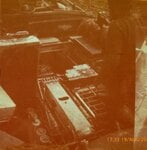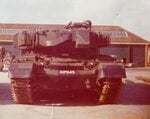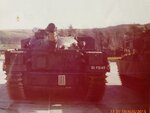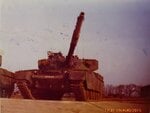May not have been the best tank engine in WWII (though better than legend suggests) but its certainly a candidate for the best sounding
Nuffield Liberty V12
When they fitted the first RR Meteor (550hp) into a Crusader for initial trials it was turned into a ''rocket.''
The Meteor became the first engine which not only provided more than sufficient power for successive British tanks (Cromwell, Comet & Charioteer).
But also proved extremely reliable in service use.
Though it was a bit overwhelmed, power to weight wise in the heavier tanks, Centurion and Conqueror. It remained reliable in the Cent, but NOT (in 810hp fuel injected form) in the Conqueror.
As an aside,
The service life of a British Military tank in the 70's was seven years or 4,000 track miles. Then they would be sent for a complete overhaul.
Tanks in Germany at the time were limited to 700 miles a year, but at the unit I was stationed at in the U.K. we were doing three times this amount in the same period and attracted a lot of interest from ATDU and a company that had something to do with The Belzona Project (cylinder liner sealing on the L60. Which was it's biggest problem (of quite a few!) and the reason for most engines being changed.
These L60's were fitted with a Service Counter (a small intrument much like a mileage reading on an odometer) that counted hours running time.
The Meteor Mk IVB's in the Centurions which we were still using in Mk 12 and Mk 13 versions along with ARV's would last all of this in most cases (4,000 mi / 7 years).
I only ever remember the occasional nightmare of spark-plug changes.
Whereas the Chieftains (Mark 2 and Mark 3G) using the L60 Mark 4A/5A were a different matter altogether!
Transmissions were reliable. Never remember any being changed in Cents; occasionally changed in Chieftains. Though the centrifugal clutch on Chieftain was not very durable.
Both used metal dry pin tracks which stretched over time and once (IIRC) four links had been removed it was time for ''track bashing,'' fitting a complete new track. The life of tracks was dependent on where they were used. In sandy conditions, not very long at all. In wet, muddy conditions, undertandably much longer.
The running gear and final drive on both AFVs, was reliable.
The Cent engine & transmission hardly ever leaked fluid, the Chieftain was not so lucky.
The first attachment (digital pic of an old paper type photo) was taken "somewhere in Germany" of the L60 in a Chietain Mk 2 that had thrown a rod after a total of 61 miles (100kms) from being fitted: An unusual occurance to be fair.
The other attachments (3) is of one (of six) brand new Mark 3G Chieftains issued to our squadron at the time, which were initially offered by the UK Gov to Iran but cancelled for some reason or another and we ended up with them.
Attachments
Last edited:




